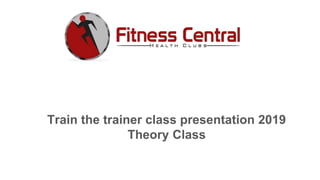
Principles of training
- 1. Train the trainer class presentation 2019 Theory Class
- 2. Principles Of Training Week 4 Training Trainer: Emelieze Isioma & John Adeboye Duration: 2 hours
- 3. Principles Of Training Understanding the principles/mechanics behind what work put in to improve an exercise program is key. In order for one to get the most out of training, you must follow some basic key principles which are; ● Individuality ● Specificity ● Progression ● Overload ● Adaptation ● Recovery ● Reversibility
- 4. Individuality People differ and respond to training very distinctively. While some people are able to handle higher levels of loads and training, others respond better to higher intensities. These disparities are based on a combination of factors such as genetic abilities, the predominance of muscle fibers(i.e slow or fast muscle fibers), athletic age and mental state. E.g Tola whose lineage is made up of sprinters would probably perform better in an agility exercise program than Mary who has only begun exercising 2 weeks ago.
- 5. Specificity: This principle relates to ensuring that the training is specific to the sport or activity a person is looking to improve on. For instance, one who aims to become a good basketball player would focus on agility/functional training and not on power- lifting. Swimming would help improve your aerobic endurance but won’t develop tissue elasticity and muscular endurance for your running legs.
- 6. Progression: To achieve your goal of running a marathon, you must first practice jogging for a period of time. Same also, in order to execute the box jump one must first learn how to do a squat jump and then further progress to a tuck jump. You’ll also need to build core strength as well as balance well enough to repeat the necessary motions enough time to finish (this would be further explained in Program Design, week 7).
- 7. Overload: In order to progress and improve our fitness, we have to put our bodies under additional stress. So also to increase strength and endurance, you need to add new resistance or time/intensity to your workouts. This principle works in agreement with progression. To run a 10-kilometer race, athletes need to build up distance over repeated sessions in a reasonable manner in order to improve muscle adaptation as well as improve soft tissue strength/resiliency. Any demanding exercise attempted too soon risks injury. The same principle applies to strength and power exercises. Overload can be achieved through the FITT method i.e Frequency, Intensity, Time and Type (this would be further explained in Program Design, week 6).
- 9. Adaptation: This principle only proves what is true of the human body, that the body adjusts to whatever climate/temperature may occur to survive. The same applies to exercise. Overtime, the body gets accustomed to exercising in at a given level. This adaptation results in improved efficiency, less effort and less muscle breakdown at that level. That is why the first time a person starts an exercise program, muscle soreness occurs - this is the body’s own way of adapting to the new activity - but with some consistency in the exercise program, such muscle fatigue may not occur. That is why you need to change stimulus through higher intensity or longer duration in order to continue improvements. The same holds true for adapting to lesser amounts of exercise.
- 10. Recovery: The body can not repair itself without rest and time to recover. Both short periods, like hours between multiple sessions in a day and longer periods like days or weeks to recover from a long season, are necessary to ensure your body does not suffer from exhaustion or overuse injuries i.e muscle tears. Over-enthusiastic athletes often neglect this. By natural law, that the more you train the more sleep your body needs, despite the adaptations your body may have made to said training. An example of this could be having your Leg day back to back with no day in-between for recovery. Variance; trying to vary your training, keeps you interested and gives your body a different challenge. A change in an exercise routine is as good a rest. Most professional athletes play a different sport in between their main season, to keep their fitness up whilst still having a rest.
- 11. Recovery contd.
- 12. Reversibility: This principle basically stipulates that, if you stop training then the improvements you have made will be reversed. That is to say, if one discontinues application of a particular exercise like running for miles or deadlifting 225lbs for 8 sets, one will lose the ability to successfully complete that exercise. Your muscles will atrophy(i.e gradually decline in effectiveness due to underuse) and the cellular adaptations like increased blood flow to the muscles and mitochondria density(this allows one to train/compete faster and longer) will reverse. For instance, one falls ill or travels for a duration without keeping up with his/her exercise routine, you may need to resume training at the point you left off. This rate of loss substantially can be slowed down by conducting a maintenance/reduced program of training during periods where life gets in the way(work, family etc), and is why just about all sports coaches ask their athletes to stay active in the off-season.
- 14. Summary In summary, these principles are why practicing frequently and consistently are so important if performance is to be improved.